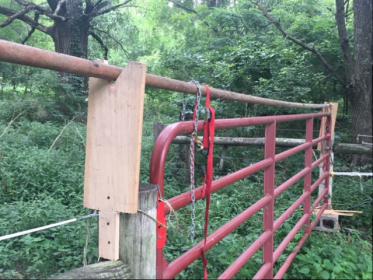Hubby’s away, and one of my main gates needed re-hung. Clamps worked loose and the gate was too out of whack to fix with subtle adjustments and re-tightening. Plus the hanger-side post isn’t completely plumb, so you have to finesse the angles of the clamps to get the gate to swing correctly. (I know, another method is to adjust the two bolts in/out, but the nuts are rusted so that wasn’t one of my available solutions today).
My go-to method is to put a car jack on each side of the gate, so you can loosen the clamps without the gate sliding through, and lift it up as needed. But normally I’d do that with a helper who can steady the top of the gate to make sure it doesn’t tip. Fussed around with my car jack method today but it was too unstable. And not producing good results, anyway-- I’d jack it up to the height I wanted, tighten the clamps, take each jack down, test the swing, and it’d still be way off. Start all over again.
So I decided to really hang the damn gate, by suspending it from above. Cut a little cradle in two pieces of plywood and tacked that to each post, and used a 20ft well pipe to span the gate opening. And then hung the gate from that pipe with tie-down ratchet straps. Worked like a DREAM. The gate served as its own plumb bob, I could make fine height adjustments with the ratchet straps, and it was a cinch to tighten the clamps on the gate once I had it in position. Gate is perfect now, opens and closes nice and level, with fingertip pressure.
Anyway, thought I’d share this idea, because it made quick work of a task that normally needs two people and lots of patience. I know not everyone will have a 20ft long pipe lying around like I did, but it sure came in handy today.
[ATTACH=JSON]{“data-align”:“none”,“data-size”:“full”,“title”:“IMG_4063.JPG”,“data-attachmentid”:10210969}[/ATTACH]

